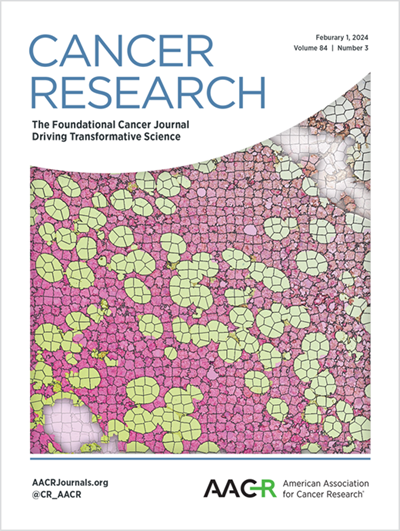Abstract CT052: A highly selective, brain-penetrant and overcoming G2032R resistance ROS1 inhibitor JYP0322 in NSCLC patients with ROS1 fusion
IF 12.5
1区 医学
Q1 ONCOLOGY
引用次数: 0
Abstract
Background: JYP0322 is a potent, brain-penetrant and highly selective ROS1 inhibitor, demonstrating over 100-fold selectivity for ROS1 compared to TRKA and sub-nanomolar potency against the ROS1 G2032R resistance mutation. JYP0322 is designed to simultaneously address the key clinical challenges including ROS1 resistance mutations, tumor brain metastases while avoiding the off-target neurotoxicity associated with TRK inhibition. Method: The Phase I study (NCT06128148) was designed to evaluate safety, pharmacokinetics (PK), and preliminary clinical efficacy in patients with locally advanced or metastatic ROS1+NSCLC, including both ROS1 TKI pre-treated patients as well as TKI naïve patients. Response was assessed by investigators according to RECIST V1.1. Results: As of December 10, 2024, dose escalation study was conducted across 7 dose levels: 50mg qd, 100mg qd, 200mg qd, 100mg bid, 150mg bid, 200mg bid, 150mg tid and dose expansion stage is ongoing at doses of 100mg bid, 150mg bid and 150mg tid. A total of 73 NSCLC patients were enrolled. No dose-limiting toxicities were observed. The most frequently reported treatment related adverse events (TRAE) were low grade including weight gains (32.9%), hyperglyceridemia (31.5%), hypercholesteremia (26%), and AST elevation (21.9%). Grade 3-5 TRAE occurred in 12.3% patients. Only low grade neurotoxicities (6.8%) occurred. Among 58 efficacy evaluable patients, objective response rates (ORRs) were 85.7% (12/14) for ROS1 TKI naive, 54.5% (12/22) for patients previously received ≥2L systemic therapy and ≥1 prior ROS1 TKIs including 19 patients pre-treated with 2 to 4 ROS1 TKIs (Table). In ROS1 G2032R mutant cancers, ORR was 71.4% (5/7) with 3 patients pre-treated with Lorlatinib. In patients with measurable brain metastasis at baseline, intracranial ORR was 33.3% (2/6) and intracranial DCR was 83.3%. JYP0322 showed significantly brain penetration ability with the brain to plasma ration 1.20. Enrollment in the dose expansion stage is ongoing. Conclusions: JYP0322 had a favorable safety profile with a low incidence of neurotoxicities. It showed highly promising anti-tumor effects in patients with ROS1+NSCLC including both TKI-naïve and TKI pre-treated patients, as well as those with TKI-heavily treated, brain metastases, or harboring ROS1 G2032R mutation. Citation Format: Hongyun Zhao, Yanqiu Zhao, Yuxiang Ma, Yan Zhang, Zhangzhou Huang, Ying Cheng, Zhengbo Song, Yongzhong Luo, Juan Li, Wei Wei, Yaling Qi, Binyan Xia, Yuexia Zeng, Jing Lv, Li Zhang. A highly selective, brain-penetrant and overcoming G2032R resistance ROS1 inhibitor JYP0322 in NSCLC patients with ROS1 fusion [abstract]. In: Proceedings of the American Association for Cancer Research Annual Meeting 2025; Part 2 (Late-Breaking, Clinical Trial, and Invited s); 2025 Apr 25-30; Chicago, IL. Philadelphia (PA): AACR; Cancer Res 2025;85(8_Suppl_2): nr CT052.摘要CT052:一种高选择性、脑渗透、克服G2032R耐药ROS1抑制剂JYP0322用于ROS1融合的NSCLC患者
背景:JYP0322是一种有效的,脑渗透和高选择性的ROS1抑制剂,与TRKA相比,对ROS1的选择性超过100倍,对ROS1 G2032R抗性突变的亚纳摩尔效力。JYP0322旨在同时解决ROS1耐药突变、肿瘤脑转移等关键临床挑战,同时避免TRK抑制相关的脱靶神经毒性。方法:该I期研究(NCT06128148)旨在评估局部晚期或转移性ROS1+NSCLC患者的安全性、药代动力学(PK)和初步临床疗效,包括ROS1 TKI预处理患者和TKI naïve患者。研究者根据RECIST V1.1评估反应。结果:截至2024年12月10日,剂量递增研究在7个剂量水平上进行:50mg qd、100mg qd、200mg qd、100mg bid、150mg bid、200mg bid、150mg tid,剂量扩展阶段在100mg bid、150mg bid和150mg tid剂量下进行。共有73名NSCLC患者入组。未观察到剂量限制性毒性。最常见的治疗相关不良事件(TRAE)是低级别,包括体重增加(32.9%)、高甘油血症(31.5%)、高胆固醇血症(26%)和AST升高(21.9%)。3-5级TRAE发生率为12.3%。仅发生低度神经毒性(6.8%)。在58例可评估疗效的患者中,ROS1 TKI初始患者的客观缓解率(orr)为85.7%(12/14),先前接受≥2L全身治疗和≥1个ROS1 TKI的患者的客观缓解率(orr)为54.5%(12/22),其中19例患者预先接受2至4个ROS1 TKI治疗(表)。在ROS1 G2032R突变型癌症中,ORR为71.4%(5/7),其中3例患者预先接受Lorlatinib治疗。基线时可测量脑转移的患者,颅内ORR为33.3%(2/6),颅内DCR为83.3%。JYP0322具有显著的脑穿透能力,脑等离子比为1.20。剂量扩大阶段的入组工作正在进行中。结论:JYP0322具有良好的安全性,神经毒性发生率低。它在ROS1+NSCLC患者中显示出非常有希望的抗肿瘤作用,包括TKI-naïve和TKI预处理患者,以及TKI重度治疗、脑转移或ROS1 G2032R突变的患者。引用格式:赵红云,赵艳秋,马玉祥,张艳,黄章洲,程颖,宋正波,罗永忠,李娟,魏伟,齐雅玲,夏彬艳,曾月霞,吕静,张丽。ROS1融合NSCLC患者的高选择性,脑渗透和克服G2032R耐药ROS1抑制剂JYP0322[摘要]。摘自:《2025年美国癌症研究协会年会论文集》;第二部分(最新进展,临床试验,并邀请s);2025年4月25日至30日;费城(PA): AACR;中国癌症杂志,2015;35(8):391 - 391。
本文章由计算机程序翻译,如有差异,请以英文原文为准。
求助全文
约1分钟内获得全文
求助全文
来源期刊

Cancer research
医学-肿瘤学
CiteScore
16.10
自引率
0.90%
发文量
7677
审稿时长
2.5 months
期刊介绍:
Cancer Research, published by the American Association for Cancer Research (AACR), is a journal that focuses on impactful original studies, reviews, and opinion pieces relevant to the broad cancer research community. Manuscripts that present conceptual or technological advances leading to insights into cancer biology are particularly sought after. The journal also places emphasis on convergence science, which involves bridging multiple distinct areas of cancer research.
With primary subsections including Cancer Biology, Cancer Immunology, Cancer Metabolism and Molecular Mechanisms, Translational Cancer Biology, Cancer Landscapes, and Convergence Science, Cancer Research has a comprehensive scope. It is published twice a month and has one volume per year, with a print ISSN of 0008-5472 and an online ISSN of 1538-7445.
Cancer Research is abstracted and/or indexed in various databases and platforms, including BIOSIS Previews (R) Database, MEDLINE, Current Contents/Life Sciences, Current Contents/Clinical Medicine, Science Citation Index, Scopus, and Web of Science.
 求助内容:
求助内容: 应助结果提醒方式:
应助结果提醒方式:


